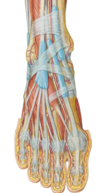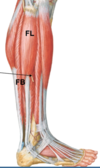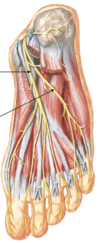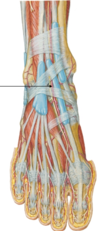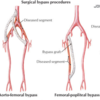Leg and Ankle Flashcards
1
Q
crural fascia:
A
- deep fascia of the leg
- gives rise to three septum that divide the leg into four compartments
2
Q
Label:

A
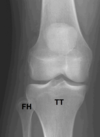
3
Q
Label:
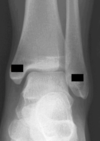
A

4
Q
Label:

A
TibiofibularJoint
5
Q
What bone of the ankle articulates with the tibia and fibula?
A
- talus
6
Q
What bone sits on top of calcaneous?
A
talus
7
Q
What bones articulate with talus?
A
- inferior: calcaneous
- anterior: navicular
8
Q
Bones in the following compartments:
- hindfoot
- midfoot
- forefoot
A
- hindfoot: talus and calcaneous
- midfoot: navicular
- forefoot: metatarsals
9
Q
sustentaculum tali:
A
- shelf part of the calcaneus which supports the talus
- where the spring ligament attaches

10
Q
Structure of the talus:
A
- trochlea: articulates with tibia/fibula
- neck: articulates with sustentaculum tali/calcaneous
- head: articulates with navicularis & sustentaculum tali/calcaneous

11
Q
What part of the foot allow for twisting motion of the foot?
A
- midfoot: navicular bone
12
Q
Label:

A
- CB = cuboid
- LC = lateral cuneiform

13
Q
Septum of the leg:
A
- arise from the crural fascia
- anterior intermuscular septum
- posterior intermuscular septum
- transverse intermuscular septum
14
Q
Borders of the leg compartments:
A
-
anterior intermuscular septum:
- divides anterior from lateral
-
posterior intermuscular septum:
- divides lateral from posterior superficial
-
transverse intermuscular septum:
- divides poseterior superficial from deep posterior
-
Interosseous membrane:
- divides deep posterior from anterior

15
Q
Anterior Compartment syndrome:
A
- When pressure is increased in the anterior leg compartment such that the vascular supply collapses and the superficial fibular nerve is compressed.
- Due to exercise overactivity or trauma.
16
Q
Symptoms of compartment syndrome:
A
- pain much more severe than consistent with injury
- burning pain
- leg tightness
17
Q
Treatment of compartment syndrome:
A
fasciotomy
18
Q
Label:

A

19
Q
Anterior leg muscles, from lateral to medial:
A
DHT
- Ext. Digitorum Longus (EDL)
- Ext. Hallucis Longus (EHL)
- Tibialis Anterior (TA)
20
Q
Point of vulnerability for common fibular nerve:
A
- head of the fibula - very superficial
- winds around, then goes into the lateral compartment first, and deep fibullar nerve goes to the front

